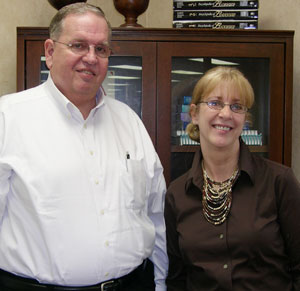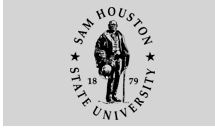New Profs Plant Service Seeds
 |
| George Moore and Jane Haggard plant
the seeds of service learning to community college leaders
and other educators through their presentation of a class
project conducted by a group of Haggard's students. |
A class project that unexpectedly turned into a service-learning
project for one SHSU educational leadership and counseling
professor while teaching at Blinn College is now being used
as an example of such for other educators across the state.
Assistant professors Jane Haggard and George Moore, both new
to the university’s educational leadership and counseling
department, will present on the project for the second time
this year this weekend (Feb. 22-23) during Texas A&M University’s
7th Annual Assessment Conference.
Their hope of inspiring educators to incorporate the idea
of service learning into their curriculums through their presentations
is February’s American Democracy Project Service Spotlight.
While teaching at Blinn, Haggard gave her six groups of public
speaking students a project for which they were to pretend
they were giving a speech at a national conference.
One of those groups went to Haggard with an idea to use their
speech for something beneficial to the child advocate organization
CASA: honoring members of the group’s volunteer base.
“They went in, determined what the need was and determined
that the volunteers needed more recognition, so they set up
this process of getting people they wanted to honor,”
Haggard said.
The five students then set up a ceremony, sent out invitations
and paid tribute to three volunteers in front of an audience
that included judges and other dignitaries.
“It emerged into a service-learning project,”
she said.
After coming to SHSU, Haggard and Moore, both of whom have
an interest in service-learning and civic engagement, discussed
the project one day and found they “both embraced the
same ideals about teaching,” Moore said.
They then decided to make a case-study presentation over the
project.
The two presented at the National Conference on Civic Engagement
in Austin earlier in the month, and Haggard’s project
was even mentioned in the textbook “Ethics and the Foundations
of Education: Teaching Convictions In A Postmodern World”
by Patrick Slattery and Dana Rapp.
During the presentations, the two “kindred spirits”
discuss experiential learning, the methodology of service
learning and its five steps, which include preparation, action,
reflection, recognition and evaluation, Haggard said.
Haggard generally presents on service-learning itself, while
Moore discusses collaboration in learning; authentic learning,
which is making the learning fit into the real-world situations
students will have to face one day; and constructivism.
The two also discuss the case study in their classes at SHSU,
“planting the seed” for future community college
leaders, school curriculum coordinators and even principals
“to champion initiatives that will forward civic engagement
as a social responsibility,” Haggard said.
“I highlighted this particular exemplar in my class
because I’m hoping that they are inspired by it, and
whenever they get in those positions, they will have the possibility
of having it forwarded under their leadership,” she
said, adding that the project was inspiring even for her.
The students involved in the project also responded well to
their work.
“I began this semester just wanting to make an ‘A’
in the course but learned my true goal for this project was
to make a lasting impression,” one student wrote in
reflection of the project.
“This project was definitely a learning experience and
made an enormous impression on my life,” another wrote.
“Although it required many hours and much planning,
the end result was incredibly rewarding.”
One of her students in the group at Blinn was so inspired
that she became an advocate for the organization after the
project, Moore said.
Haggard and Moore stress the intrinsic motivation and giving
students a lesson with a “real context” not only
to support the use of service-based learning in their presentation
but also encourage the audience to find their own niches for
the concept.
“This (Haggard’s project) is a good example of
how service learning can be used but it’s in one isolated
public speaking class,” Moore said. “One of the
things we do at the end of our presentation is that we get
the participants in the audience to talking about how in their
discipline they might be able to incorporate something like
this.”
—END—
SHSU Media Contact: Jennifer
Gauntt
Feb. 22, 2007
Please send comments, corrections, news tips to Today@Sam.edu.
|


